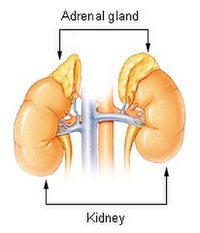
Photo from wikipedia
Background Incidental imaging findings (incidentalomas) are common, but there is currently no effective means to investigate their clinical relevance. Purpose To introduce a new concept to postprocess a medical imaging… Click to show full abstract
Background Incidental imaging findings (incidentalomas) are common, but there is currently no effective means to investigate their clinical relevance. Purpose To introduce a new concept to postprocess a medical imaging examination in a way that incidentalomas are concealed while its diagnostic potential is maintained to answer the referring physician's clinical questions. Material and Methods A deep learning algorithm was developed to automatically eliminate liver, gallbladder, pancreas, spleen, adrenal glands, lungs, and bone from unenhanced computed tomography (CT). This deep learning algorithm was applied to a separately held set of unenhanced CT scans of 27 patients who underwent CT to evaluate for urolithiasis, and who had a total of 32 incidentalomas in one of the aforementioned organs. Results Median visual scores for organ elimination on modified CT were 100% for the liver, gallbladder, spleen, and right adrenal gland, 90%–99% for the pancreas, lungs, and bones, and 80%–89% for the left adrenal gland. In 26 out of 27 cases (96.3%), the renal calyces and pelves, ureters, and urinary bladder were completely visible on modified CT. In one case, a short (<1 cm) trajectory of the left ureter was not clearly visible due to adjacent atherosclerosis that was mistaken for bone by the algorithm. Of 32 incidentalomas, 28 (87.5%) were completely concealed on modified CT. Conclusion This preliminary technical report demonstrated the feasibility of a new approach to postprocess and evaluate medical imaging examinations that can be used by future prospective research studies with long-term follow-up to investigate the clinical relevance of incidentalomas.
Journal Title: Acta Radiologica
Year Published: 2023
Link to full text (if available)
Share on Social Media: Sign Up to like & get
recommendations!